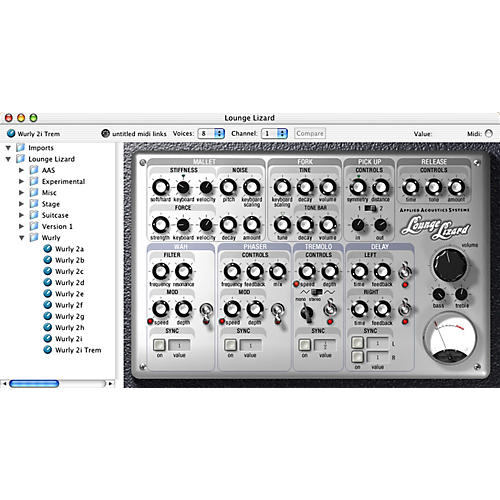Why Shop With Us?
Free Shipping
Free Standard Ground shipping (48 contiguous states, some overweight and Used/Vintage items excluded).
Orders placed before 3 p.m. ET usually ship the same business day.
Learn More2-Year Free Warranty on Guitars
Every guitar or bass you purchase from Musician's Friend (electric or acoustic, New or Open Box) includes two years of protection from manufacturer defects.
Contact Us for DetailsWe're Here for You
Our Gear Advisers are available to guide you through your entire shopping experience. Call or Chat for expert advice and to hear the latest deals.
Contact UsContact Us
Hablamos Español
866.226.2919
Hours:
MON - FRI 5 AM - 8 PM PT
SAT 6 AM - 6 PM PT
SUN 6 AM - 5 PM PT

Lounge Lizard EP-2 Electric Piano Virtual Instrument
false falseWe're sorry-this item is unavailable.
Contact our experts for a recommendation of great alternatives. Call us at 800-449-9128.
Astounding realism and tweakability.
New features include a key release model for even greater realism. Choose between the Lounge Lizard's original pickup model acclaimed for it's growl and bite or a new secondary model specifically designed for crystal clean tones.
Other New Features:
All effects modulation and stereo delays sync to host tempo.
Support for MIDI program change for handsfree operation
New browser interface makes finding presets quick and easy
Optimized DSP engine for 3 times greater CPU performance
Support for Digidesign's RTAS plug-in format for Pro Tools 6.x
Support for OS X
Because the sound is calculated in real time in accordance with the controls it receives from your MIDI keyboard and on-screen knob movements, the Lounge Lizard will produce a slightly different sound if the tine is in motion than when it is at rest. Great care was taken in the development of Lounge Lizard to provide access to all of the various components in an intuitive manner, giving you the power to tweak your sound in a way that would have taken many painstaking hours with a screwdriver and incredible patience to accomplish with the real thing. Far from being just a collection of good presets, the Lounge Lizard is a custom sound designing tool sure to please any discerning keyboard enthusiast. While the various models give you the ability to create unparalleled reproductions of classic electric piano sounds, all of the parameters can also be pushed far beyond the range of their hardware equivalents, opening up a completely new realm of sonic possibility. Using an external MIDI knob box or continuous controller messages (cc envelopes) from your host sequencer, this idea can be taken even further, allowing you to modulate various on-screen parameters in real time, creating ever-changing tones, from the sublime to the ridiculous!
The mallet module has parameter controls for the material properties of the mallet head (stiffness), the striking force, and the audible noise the impact creates. The stiffness parameters allow you to change the mallet's material from felt tip to solid steel with the twist of a single knob and to change the stiffness in response to the information received from the keyboard.The force parameters regulate how hard the mallet hits the tone bar and how this changes in response to the keyboard.
The noise parameters allow you to adjust the volume and color of the sound of the mallet's impact and the way this is altered by the keyboard. Setting the keyboard scaling all the way to the left gives the impact noise a long decay on the lower octaves and short decay in the upper range. Setting this parameter around 11 o'clock produces a more or less equal decay time across the entire range of the keyboard.
The fork module is comprised of 2 elements: the tone bar and the tine. The tine is the smaller of the 2 and is directly struck by the mallet. Its controls allow you to adjust how its pitch responds to the keyboard, its volume, and its decay, or how long it resonates after being struck by the mallet. This is one particular area where physical modeling provides a uniquely accurate synthesis of an actual electric piano. Unlike multi-sampled solutions, which provide various recordings for different velocities across the keyboard, the algorithms used in the physical models produce a different timbre if the tine is at rest or in motion when it is struck by the mallet, something that would take literally hundreds of samples to reproduce accurately! The tone bar is not directly struck by the mallet but instead, "passively resonates" when the tine is struck. The module allows you to adjust the volume and decay of the tone bar, as well as how the decay is affected by the keyboard, just like the noise parameter of the mallet.
Far from being a simple amplifier, the pickup module greatly effects the overall tone of the Lounge Lizard. The symmetry parameter adjusts the pickup's vertical position in relation to the tine. In a real electric piano, this was one of the key elements in tuning the instrument, as well as one of the reasons why 2 electric pianos of the same model could sound slightly different from each other. When the green light is on, the pickup is perfectly aligned with the tine, and the pure overtone is heard. Moving the pickup above or below the line of symmetry decreases the amount of overtone and alters the overall timbre.The distance parameter, as the name implies, adjusts how far the pick is from the fork. Turning this knob to the left moves the pickup farther away from the fork and makes the sound quieter. Turning it to the right amplifies the sound but also changes the shape of the sound and alters the overall tone.
Version 2 introduces a second pickup model which is the result of measurements taken from other pickups found in electric pianos. This second model produces a characteristically brighter sound. The switch in the middle of the pickup allows you to select between the original EP-1 model acclaimed for it's grit and bite and the new secondary model. Finally, the amp controls allow you to adjust the signal level pre- and post-pickup.
A release parameter in traditional synths is used to control the amount of time it takes for the sound to decay to silence. In the case of the Lounge Lizard, it is also a physical model of the interaction of the tine with the damper at the attack time when the damper moves away from the tine and at the release time when the damper mutes the tine. Thus the release parameters control not only the duration of the release but also the duration and timbre of the added noise as a result of this interaction of the damper and the tine. Appropriate settings of the release parameters greatly add to the realism of the Lounge Lizard's emulation of various vintage pianos. They may also be pushed to extreme settings to create a vast array of unique percussive effects.
The Lounge Lizard's wah effect is a monophonic bandpass filter modeled after those found in popular guitar effects like the classic Cry Baby pedals. The on-screen knobs allow you to adjust the center frequency and resonance of the filter. The center frequency can also be modulated by an LFO with a triangle wave form. The speed parameter adjusts the rate or frequency of the LFO while the depth knob allows you to set how much the LFO will effect the frequency range - in other words, how wide a sweep the filter will have.The switch on the wah, and all the effects for the that matter, not only allows you to turn the effect on or off, it also stops your computer's processor from calculating the filter in the off position, preventing unnecessary CPU drain. Version 2 adds the sync parameter to all of the effects, which allows the modulators (LFOs) for the wah, phaser, and tremolo, as well as the stereo delays, to sync to host tempo when used as a VST, DXi, or RTAS plug-in.
The phaser alters a signal by removing frequency bands from its spectrum. The effect is obtained by changing the phase of the frequency components of a signal using an all-pass filter and adding this new signal to the original one. In simple terms the phaser can almost be seen as an inverse wah effect.The on-screen controls give you control over the frequency range of the all pass filter, a mix knob for the dry and wet versions of the signal, and the amount signal that is fed back into the all-pass filter, or feedback. The phaser also incorporates the LFO modulator used in the wah effect and an on/off switch which also shares the same characteristics. A slightly mellower sounding effect than the wah, the phaser is an excellent effect for adding subtle colour or warmth to your presets. As with the wah effect, the phaser can also sync to host tempo.
The tremolo effect is easily the most often associated with the classic electric piano sound, as many of the most popular electric pianos had this effect built in. The Lounge Lizard's tremolo effect is accomplished by modulating the output signal's amplitude with an LFO similar to the one found in both the phaser and wah effects. The difference here is that you have 2 wave forms to choose from: the triangle as in the other 2 effects and a specially formulated triangle/square mixed wave form hybrid wave form to accomplish their tremolo effects and not a simple triangle. The tremolo effect can be used in mono (for all you purists out there) or stereo and features the same on/off switch as above. As with the other effects, the tremolo can also sync to host tempo.
The Lounge Lizard also features a high-quality stereo delay modeled after the classic analog delay boxes. Independent controls are given for the left and right delays for both feedback and delay time. Special care was taken in designing the delay to provide a very wide range of delay times. Turned to the left until around 3 o'clock, the Lounge Lizard's delay is capable of creating various subtle chorusing effects, an excellent feature when you want to give the piano a little more space in the mix. Settings above this point provide everything from subtle echo to sheets of classic reggae dub wash. Both the left and right delays can be independently synced to host tempo.
Features
- Key release model
- All effects modulation and stereo delays sync to host tempo
- Support for MIDI program change for hands-free operation
- New browser interface makes finding presets quick and easy
- Optimized DSP engine for 3 times greater CPU performance
- Support for Digidesign's RTAS plug-in format for Pro Tools 6.x
- Support for OS X
Order today for fantastic electric piano sounds!
Lounge Lizard EP-2 Electric Piano Virtual Instrument Specifications:
- System Requirements
- Windows PC
- Windows 98, ME, 2000, XP
- 800x600 or higher
- PIII 500MHz processor
- 32MB RAM
- Supported sound card drivers: ASIO, WDM, MME
- Supported plug-in formats: DXi, VST
- Mac
- Mac OS 10.2 or later
- 800x600 or higher
- G3 processor
- 128MB RAM
- Supported sound card drivers: CoreAudio
- Supported plug-in formats: VST, RTAS, Audio Units
- Free Standard Ground shipping (48 contiguous states, some overweight and Used/Vintage items excluded).
- Orders placed before 3 p.m. ET usually ship the same business day.
Every guitar or bass you purchase from Musician's Friend (electric or acoustic, New or Open Box) includes two years of protection from manufacturer defects.
Our Gear Advisers are available to guide you through your entire shopping experience. Call or Chat for expert advice and to hear the latest deals.

Musician's Friend Support





































































































































